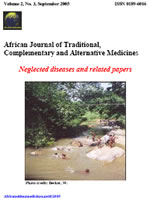
|
African Journal of Traditional, Complementary and Alternative Medicines
African Ethnomedicines Network
ISSN: 0189-6016
Vol. 7, Num. 4, 2010, pp. 377- 377
|
African Journal of Traditional, Complementary and Alternative Medicines, Vol.
7, No. 4, 2010, pp. 377- 377
Review Of The Book “Essentials Of Tibetan Traditional Medicine” By Thinley Gyatso & Chris Hakim
Dr. Narendra Singh, MBBS, MD, B.Sc., MD (AM), FICN, FICS, FAL, FISHM, MISHR, MIPS,MAFCP, MICRS
International Institute of Herbal Medicine (IIHM)
Lucknow
E-mail: drnsingh@organicindia.com
Code Number: tc10039
The Essentials of Tibetan Traditional Medicine by Thinley Gyasto and Chris Hakim is a good attempt to represent Tibetan Ancient Medical knowledge in a very simplified manner. This can be understood by any Herbalist or a lay person alike as it is so simple. I have a chance to stay in Dharamshala in 1960’s, then in the province of Punjab, now is part of Himachal Pradesh, another state of India. The Tibetan Medical and Astrological Institute for Tibetan Medicine is at the height of 8000 feet in Himalayas, which is akin to Tibetan environment. Thus, developing and using Tibetan medicine in its natural surrounding is a time honoured thought for Traditional Medical system. The book is a mini Ayurveda (The Science of Life). The three disorders of Vata (wind), Kaph (phlegm) and Pitta (bile) are the main seat for description, diagnosis and treatment of diseases. While such exact translation of these disorders have been discussed and analyzed in different ways now in Ayurveda, the Tibetans maintain the same meaning as can be translated in English. The vitiated Vata (wind), Kaph (phlegm) and Pitta (bile) produce according to their disturbances, which effect various vital organs of the human body causing related diseases. As one can understand the meaning of existence, style of living and medicines in a place are commensurate with environmental conditions. The heights of Tibetan plateau in Himalayas, the snow and cold weather with low oxygen and increased ultraviolet exposures allow one to need more energy for better survival, thus, sugarcane juice, sugar products and honey are essential for providing instant energy to human body. Various meat products (high proteins) are needed to sustain heat energy for muscular function. The book describes treatments conforming to the needs of people of Tibet. The spices like coriander, pepper, cardamom etc. along with mineral pitch are good for digesting meat proteins and help energy needs. Thus, the book provides, the needed formudlations, combinations of Indian and Chinese herbs and meat products which will suit Tibetan people and can be helpful in cold climate countries also, where oxygen levels are low due to environmental pollution and there is increase in ultraviolet rays of sun because of ozone depletion (ozone holes) causing many ill effects on health specially skin cancers. During my visit to the cold Indo-Tibetan high mountains with low oxygen levels and 9 times more ultraviolet ray’s exposures, making skin to peel often, I found Jaggery (crude sugar) use was the most energy provider along with some local wines used by Tibetans. I recommend this book for general readers and medical professionals, who are interested in the value of complementary medicine (amchis of Tibetan) for human health and diseases. ERRATA 1) Potduang et al., Afr. J. Trad. CAM (2007) 4 (2): 156 – 164, BIOLOGICAL ACTIVITIES OF SCHEFFLERA LEUCANTHA Page 159, Paragraph 1, Line 3 of Anti-tyrosinase assay “In a 96-well micro-plate, mixed 150µl of 0.02M sodium phostphate buffer (pH 6.8) with 50µl of the sample solution and 50µl of mushroom tyrosinase solution (314.8U/ml, Fluka). Should read “In a 96-well micro-plate, mixed 50µl of 0.02M sodium phostphate buffer (pH 6.8) with 50µl of the sample solution and 50µl of mushroom tyrosinase solution (314.8U/ml, Fluka). 2) Potduang et al., Afr. J. Trad. CAM (2008) 5 (3): 230 – 237, BIOLOGICAL ACTIVITIES OF ASPARAGUS RACEMOSUS Page 231, Paragraph 4, Line 3 of Tyrosinase inhibition “The 50 µl samplesolution was mixed with 50 µl of mushroom tyrosinase buffer solution (314.8U/ml, Fluka) and 150 µl of 0.02M sodium phosphate buffer (pH 6.8), and allowed to stand for 10 min.” should read “The 50 µl samplesolution was mixed with 50 µl of mushroom tyrosinase buffer solution (314.8U/ml, Fluka) and 50 µl of 0.02M sodium phosphate buffer (pH 6.8), and allowed to stand for 10 min.”
Copyright 2010 - Afr. J. Trad. CAM
|
